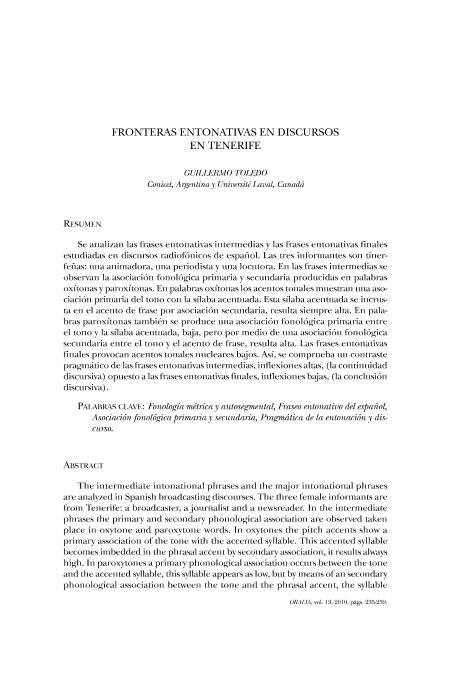Mostrar el registro sencillo del ítem
dc.contributor.author
Toledo, Guillermo Andres

dc.date.available
2023-04-03T17:37:09Z
dc.date.issued
2010-12-01
dc.identifier.citation
Toledo, Guillermo Andres; Fronteras entonativas en discursos de Tenerife; Arco Libros; Oralia; 13; 1-12-2010; 235-259
dc.identifier.issn
1575-1430
dc.identifier.uri
http://hdl.handle.net/11336/192523
dc.description.abstract
Guillermo Toledo, "Fronteras entonativas en discursos en Tenerife" The intermediate intonational phrases and the major intonational phrases are analyzed in Spanish broadcasting discourses. The three female informants are from Tenerife: a broadcaster, a journalist and a newsreader. In the intermediate phrases the primary and secondary phonological association are observed taken place in oxytone and paroxytone words. In oxytones the pitch accents show a primary association of the tone with the accented syllable. This accented syllable becomes imbedded in the phrasal accent by secondary association, it results always high. In paroxytones a primary phonological association occurs between the tone and the accented syllable, this syllable appears as low, but by means of an secondary phonological association between the tone and the phrasal accent, the syllable recovers its higher prominence. The final intonational phrases induce low nuclear accents. In this way, it suggests a pragmatic contrast of intermediate phrases cued by continuation rise contours, (the discourse continuity) opposed to the final phrases marked by low contours, (the discourse conclusion). Key words : Autosegmental and Metrical Phonology, Spanish Phrasing, Primary and Secondary Phonological Association, Intonational Meaning and Discourse.
dc.description.abstract
The intermediate intonational phrases and the major intonational phrases are analyzed in Spanish broadcasting discourses. The three female informants are from Tenerife: a broadcaster, a journalist and a newsreader. In the intermediate phrases the primary and secondary phonological association are observed taken place in oxytone and paroxytone words. In oxytones the pitch accents show a primary association of the tone with the accented syllable. This accented syllable becomes imbedded in the phrasal accent by secondary association, it results always high. In paroxytones a primary phonological association occurs between the tone and the accented syllable, this syllable appears as low, but by means of an secondary phonological association between the tone and the phrasal accent, the syllable recovers its higher prominence. The final intonational phrases induce low nuclear accents. In this way, it suggests a pragmatic contrast of intermediate phrases cued by continuation rise contours, (the discourse continuity) opposed to the final phrases marked by low contours, (the discourse conclusion).
dc.format
application/pdf
dc.language.iso
spa
dc.publisher
Arco Libros
dc.rights
info:eu-repo/semantics/openAccess
dc.rights.uri
https://creativecommons.org/licenses/by-nc-sa/2.5/ar/
dc.subject
FONOLOGÍA MÉTRICA Y AUTOSEGMENTAL
dc.subject
FRASEO ENTONATIVO DEL ESPAÑOL
dc.subject
ASOCIACIÓN FONOLÓGICA PRIMARIA Y SECUNDARIA
dc.subject
PRAGMÁTICA DE LA ENTONACIÓN Y DISCURSO
dc.subject.classification
Lingüística

dc.subject.classification
Lengua y Literatura

dc.subject.classification
HUMANIDADES

dc.title
Fronteras entonativas en discursos de Tenerife
dc.type
info:eu-repo/semantics/article
dc.type
info:ar-repo/semantics/artículo
dc.type
info:eu-repo/semantics/publishedVersion
dc.date.updated
2023-03-20T14:49:17Z
dc.identifier.eissn
2254-6723
dc.journal.volume
13
dc.journal.pagination
235-259
dc.journal.pais
España

dc.journal.ciudad
Madrid
dc.description.fil
Fil: Toledo, Guillermo Andres. Laval University; Canadá. Universidad del Cine; Argentina. Consejo Nacional de Investigaciones Científicas y Técnicas; Argentina
dc.journal.title
Oralia
dc.relation.alternativeid
info:eu-repo/semantics/altIdentifier/url/https://ojs.ual.es/ojs/index.php/ORALIA/article/view/8114
dc.relation.alternativeid
info:eu-repo/semantics/altIdentifier/doi/https://doi.org/10.25115/oralia.v13i.8114
Archivos asociados
